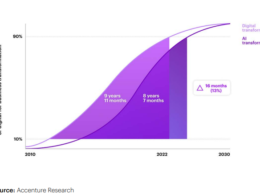This is an excerpt of the report “Fueling the AI transformation: Four key actions powering widespread value from AI, right now.”, published by Deloitte, on October 2022, edited by the editor of this site.
October 2022
Nitin Mittal, Irfan Saif and Beena Ammanath
Site Editor:
Joaquim Cardoso MSc.
health transformation — institute for research and strategy
October 20, 2022
Foreword: The era of value
In recent years, we’ve navigated unprecedented disruption in the economy and society at large.
A global pandemic. Shifting worker needs. And the general realization that none of us can continue to do business as usual.
Artificial intelligence has a unique and powerful role to play in meeting many of the challenges presented to us today.
We are further encouraged that we find ourselves living in a time when data infrastructure and processing power offer the necessary foundations to fuel truly transformational applications and rapid innovation of artificial intelligence (AI).
As we have watched these rapid shifts occur, we see the opportunities in present challenges.
And yet, we have also seen how many business leaders set their sights too low — and thus fall short — of the enormous potential AI presents to us.
Today’s race is no longer about adopting AI or automating processes for efficiency.
It is now about realizing value, driving outcomes, and unleashing the potential AI holds to drive new opportunity for our businesses, for our employees and for our society at large.
It is about cracking open the constraints of how we have done business before.
Today’s race is no longer about adopting AI or automating processes for efficiency.
It is now about realizing value, driving outcomes, and unleashing the potential AI holds to drive new opportunity for our businesses, for our employees and for our society at large.
The edition of The State of AI in the Enterprise research explores just that: how businesses are forging a path to a new future, one filled with unrealized sources of value.

We explore four key actions that many business leaders are taking to harness AI’s potential and drive value at scale across their enterprises:
- 1.Invest in culture and leadership
- 2.Transform operations
- 3.Orchestrate tech and talent
- 4.Select high-value use cases
1.Invest in culture and leadership:
Leaders should embark on reinventing work to capitalize on the growing optimism and opportunity that their human workforce sees in AI.
People are still at the core of a business’ success, and AI can help unleash the power of a combined human and machine workforce.
- Eighty-two percent of respondents indicate employees believe that working with AI technologies will enhance their performance and job satisfaction.
- The highest performing respondents (“Transformers”) were the most likely to report AI-ready cultural characteristics, such as: high cross-organizational collaboration; workforce optimism for the possibilities of AI; and actively nurturing and retaining AI professionals.
- The survey found that agility and willingness to change, combined with executive leadership around a vision for how AI will be used, are the most important factors in the development of an AI-ready culture. Change management is critical to successful AI transformation, and high-outcome organizations were more than 55% more likely to invest in change management compared to low-outcome organizations.
- Organizations are taking action to support human-machine collaboration with 43% of respondents noting their organization has appointed a leader responsible for helping workers collaborate better with intelligent machines, and 44% say they are using AI to assist in decision-making at senior-most levels.
The survey found that agility and willingness to change, combined with executive leadership around a vision for how AI will be used, are the most important factors in the development of an AI-ready culture.

2.Transform operations:
To ensure ethical and quality application of AI, the entire operating model may need to change to accommodate the unique capabilities of intelligent machines.
Workflows and roles should be reevaluated to manage risk and achieve new value.
- In both the fourth and fifth editions of this survey, operational best practices were associated with high outcomes, but most organizations have yet to make significant improvement in this area.
In both the fourth and fifth editions, just one-third of respondents say that their companies are always following best practices such as MLOps, redesigning workflows, and documenting AI model life cycles. - Managing AI risk can have a major impact on an organization’s AI efforts, with 50% of respondents citing management of AI-related risks as one of the top inhibitors to starting and scaling AI projects.
- By and large, surveyed organizations rely heavily on training as a key to mitigating AI risk. Respondents’ top two risk mitigation strategies are training developers on AI ethics (35%) and training/supporting employees who work with AI (34%).
… their companies are always following best practices such as MLOps, redesigning workflows, and documenting AI model life cycles.

3.Orchestrate tech and talent:
On the flip side of the culture and leadership coin, companies must develop their AI strategies in a tight talent market, with growing off-the-shelf platforms, tools and accelerators that can jump-start a company’s transformation.
- Given that even the most advanced organizations are still early in their transformations, a majority of organizations still prioritize bringing new AI talent into the business from outside, rather than retraining existing workers (53% versus 34%).
- A significant majority of the survey respondents acquire AI as a product or service (65%) rather than attempting to build their own AI solutions in-house (35%), leaning particularly on off-the-shelf solutions at the beginning of their journeys.
A significant majority of the survey respondents acquire AI as a product or service (65%) rather than attempting to build their own AI solutions in-house (35%), leaning particularly on off-the-shelf solutions at the beginning of their journeys.

4.Select high-value use cases:
AI is fueling transformations across all industries, and many leaders have begun to unlock which use cases are driving the most value within their given context.
The important takeaway is to orchestrate a strategy of both near- and long-term differentiating applications of AI.
Again this year, we clearly state that we are early on in the Age of With™ — an era defined by human with machine collaboration — yet we see signs that businesses are ever closer to realizing AI opportunity and applying next-level human cognition.
- The survey found the top use cases of AI across industries include cloud pricing optimization (44%); voice assistants, chatbots and conversational AI (41%); predictive maintenance (41%); and uptime/reliability optimization (41%).
- However, use cases vary by industry, for example:
– Life sciences and health care companies are the most likely to delegate ownership over AI models to individual lines of business (51%), while
technology, media and telecom companies are most likely to centralize this ownership (42%).
– Energy, resources and industrials companies are most likely to use AI to assist in decision-making at the highest levels of the company (50%), while government is least likely to do so (39%).
top use cases of AI across industries include: (1) cloud pricing optimization (44%); (2) voice assistants, chatbots and conversational AI (41%); (3) predictive maintenance (41%); and (4) uptime/reliability optimization (41%).
We hope this report supports your business in not just realizing the potential of AI, but also in imagining how much further it can take you.
-Nitin Mittal, Irfan Saif and Beena Ammanath












